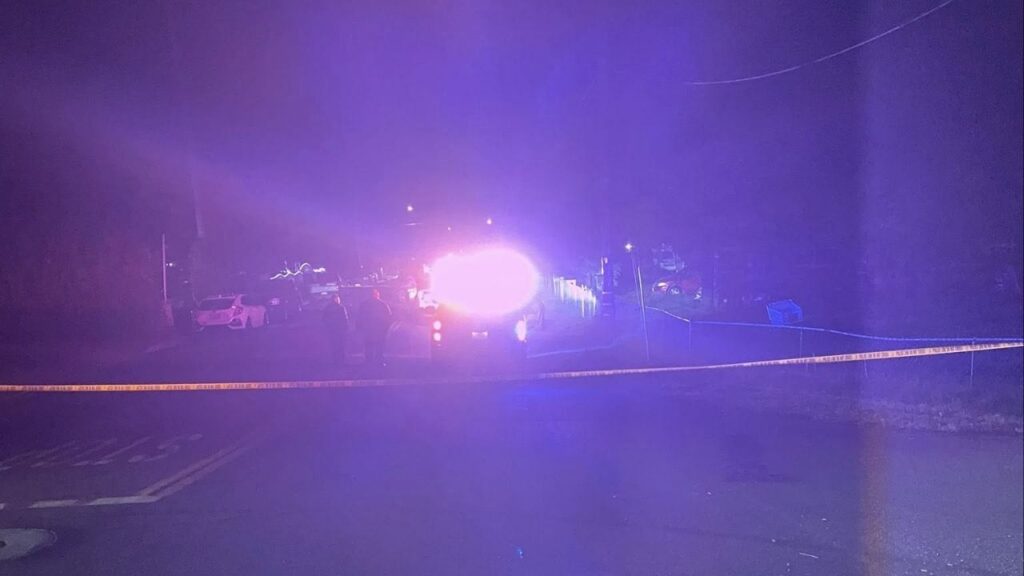Share
In a quiet corner of Elk Grove, where the maze of subdivisions and shopping centers gives way to open fields, Sharie Wilson has spent the last three years building her dream home.
It’s nothing like the neighborhood where she grew up in South Central L.A. But in this Sacramento suburb, her family owns a modern farmhouse set on 2.5 acres, with a stately U-shaped driveway and a Pan-African flag over the front door. In the backyard, there’s a basketball court inlaid with the logo of her hair care company, DreamGirls.

By Lauren Helper
CalMatters
Still, Wilson has to justify her family’s success. Neighbors have asked her husband, who works at the local water district and runs his own apparel company, what sport he plays. Or how the couple really paid for their house. “Hopefully once people keep seeing it, they stop seeing the color and start seeing us as humans,” said Wilson, a 41-year-old mother of six boys.
Wilson is one of around 275,000 Black Californians who have left high-cost coastal cities in the last three decades, sometimes bound for other states or cities, but more often to seek their slice of the American dream in the state’s sprawling suburban backyard. Many transplants pack up for the promise of homeownership, safety and better schools. Housing-rich Elk Grove has gained nearly 18,000 Black residents since 1990 — a 5,100% jump mirrored by increases around the San Joaquin-Sacramento Delta, Southern California’s Inland Empire and the Central Valley.
At the same time, Black renters have been disproportionately forced out of cities as costs and evictions climbed; the Black population has plunged 45% in Compton, 43% in San Francisco and 40% in Oakland. While a version of this geographic scramble is playing out for working and middle-class people of all races, the distinct obstacles that Black residents encounter in new communities raise the question: How far do you have to go today to find opportunity — and are some things ever really possible to leave behind?
“Part of what we’re seeing is the kind of anti-Black racism that has followed Black folks wherever they go,” said Willow Lung-Amam, an associate professor of urban planning at the University of Maryland. “You still face the same kind of structural barriers.”
In adopted hometowns, Black Californians face newer, subtler forms of segregation. Old regimes of legal housing and job discrimination have given way to predatory loans, shifting patterns of disinvestment and flare ups of racism or violence in areas that once promised a level playing field, reports from UC Berkeley, UCLA and social services groups have found.
Now, as Black Lives Matter protests collide with anxiety about COVID-19’s disproportionate Black death toll and anxiety about a coming wave of evictions, at issue is whether these overlapping crises will accelerate California’s Black exodus or force a reckoning both inside and outside major cities.
Moving Out
Wilson had never been to Elk Grove before she moved there in 2002 to start a family. She’d never been called the n-word before she moved there, either.

By 2017, after years of working a day job in sales and doing hair late into the night, her own salon in Old Town Elk Grove was thriving. She went back to L.A. often to dream up business ideas with her sister and make sure her kids weren’t too far “out of the loop” on Black culture. But one day, a stylist at Wilson’s salon found a note jammed in the door. It was riddled with racial slurs and said to “get out soon.”
“It didn’t make me want to leave,” Wilson said. “It made me want to force them to understand who I am, what I’m about, and that I add value to this community just like everybody else.”
In 2000, just before Wilson left L.A., California had the country’s second-largest Black population at more than 2.2 million people. But under the surface, a seismic shift was happening in where people lived, the opportunities they chased and the social networks they relied on.
After white flight, Black flight had accelerated in the 1980s. Outer suburbs like Palmdale, Antioch and Elk Grove saw exponential growth.
The state went from a high of 7.7% Black in 1980 to 5.5% Black in 2018, Census data shows, even as it added 15 million residents who were mostly Latino, Asian or multi-racial. Nearly 75,000 Black Californians left the state in 2018, according to a CalMatters analysis of federal estimates, compared to 48,000 Black people who moved in. The three most popular states for Black ex-Californians were Nevada, Texas and Georgia, reflecting both a national reversal of last century’s Great Migration and movement to emerging middle class hubs for Black homeownership, education and entrepreneurship.
The first time Cierra Washington-Griffin left California was in 2010, when she was 23 and fresh off a breakup. Three days on a Greyhound from her hometown of Sacramento to Fort Benning, Georgia, gave her plenty of time to think about starting over.
Within a month, she had a car, a job at a hotel and a two-bedroom duplex that cost $450 a month — a rapid shift to financial independence that had seemed impossible back home. She also didn’t have to change her voice to “sound white” like when she applied for work in affluent California suburbs. “It was just so much simpler there,” said Washington-Griffin, now 33.
Her grandmother was born in Little Rock, Arkansas, and she sees things differently. Barbara Washington followed family from St. Louis to California in the 1970s, at the tail end of the migration that brought hundreds of thousands of Black people to California from the South. Washington settled in Richmond, part of the Bay Area’s jobs-rich former “war corridor,” a center of Black life forged by discriminatory housing practices.
Washington worked as a nurse, and by the time her children were having children in the ’80s, the Bay Area seemed too fast. They moved to the “cow town” of Sacramento, and she never regretted moving to California.

“We wanted something different for the kids,” Washington said on a recent 100-degree day at a park in Elk Grove, where she moved after the house she rented in Sacramento was sold.
“See, that’s weird though,” said Washington-Griffin, who moved back in last year with plans to leave again but now is unsure. “I feel like it’s better out there, especially for people of color, in the South.”
Her grandmother shook her head. “I don’t think so,” she said.
Racial Wealth Gap Grows
Timing is everything in California’s winner-take-most economy. The longer it takes Black residents to cash in when times are good and the harder they’re hit when things turn bad, the wider the state’s racial wealth gap grows.
In Los Angeles, white households have a median net worth of $355,000, compared to $4,000 for Black households, according to an analysis by the Federal Reserve Bank of San Francisco. Studies in the Bay Area have shown that homes are twice as valuable in white neighborhoods.
For those who move in hopes of changing those daunting numbers, the challenge today is finding a “window of opportunity,” said Deirdre Pfeiffer, an associate professor of geography and urban planning at Arizona State University. Her research found that some L.A. transplants to the Inland Empire did find upward mobility in the ’80s and ’90s. But it’s been difficult to maintain because of a slow-down in building and patterns like a racial “tipping point” in suburban real estate, where white residents tend to flee as areas diversify. From there, in some cases, property values sink, tax rolls shrivel and public services like schools start to decline.
Even for many Black Californians who did manage to buy property, the financial crisis a decade ago was crushing. Cities where Black families bought houses in large numbers became epicenters of the foreclosure crisis. Antioch’s foreclosure rate of 2,446 per 100,000 residents was “hundreds of times higher than most of Silicon Valley” about an hour away, Alex Schafran wrote in his 2018 book “The Road to Resegregation: Northern California and the Failure of Politics.”

After the Fair Housing Act outlawed redlining and other legal forms of housing discrimination 50 years ago, author Keeanga-Yamahtta Taylor writes that they were replaced by a system of “predatory inclusion,” where Black residents were targeted for bad loans and higher interest rates on properties less likely to sharply appreciate. Homeownership became even more elusive after the last crash, when investors bought up thousands of houses and turned them into rentals.
LaShai Daniels didn’t know how much to worry about real estate if she wanted to stay close to home. Last fall, the 48-year-old Oakland native lost her job and had to leave her apartment in Vallejo. She lived in her car and sometimes stayed with friends — “a rubber-band state” between housed and unhoused.
“I never knew that you could take your IRA and buy property with it,” said Daniels, who has worked in medical billing and payroll for more than two decades. “If no one educates you, you don’t know these things.”
Though Black people make up less than 6% of California’s total population, about 40% of the state’s homeless residents are Black. Increasing death rates and shorter life expectancies were growing concerns even before COVID-19.
Just before the virus hit this spring, Daniels decided to do whatever it took to get a hotel. She spent days working a new job in payroll and nights at an extended-stay hotel in Emeryville. It cost $3,200 the first month, but it didn’t require applications and credit checks like an apartment. She’s now an organizer with Black-led activist group Moms 4 Housing, which has helped pay hotel bills during the pandemic. One day, Daniels hopes to open a shelter in the name of her son, who was killed at 17 by a 15-year-old with a gun.
“You don’t know where you can go and be safe,” Daniels said. “It’s just sad now that we’ve come so far to still be in the same place.”
Stay or Go?
Derek King knew he had to leave Compton when the gunfire stopped scaring him. It was 1985, and he was 15 hanging out with friends when someone started shooting into a house next door.
“We just took a step away and kept talking about Magic Johnson and the Lakers,” said King, now a 50-year-old father of four.
His ticket out came when he joined the military in 1993, just after the cops indicted for beating Rodney King were acquitted. He settled in Apple Valley and now serves as assistant superintendent of a charter school. The desert communities that make up Victor Valley have their issues — it’s been tense lately, and none of the politicians look like him — but King mostly found what he was looking for in a sprawling home with a tennis court, a pool and clear views of the surrounding hills.

Tensions are high after the late May death of Malcolm Harsch, 38, who was found hanging from a tree near a Victorville library. Protests broke out, and the state opened an investigation into the case and another hanging death of a 24-year-old Black man in Palmdale. Harsch’s family later said he died by suicide.
Victorville’s Black population has quadrupled since 1990, but it’s emblematic of many fast-growing exurbs where local institutions don’t keep up with a changing population. Most of the big Black-led social service providers and political advocacy groups are still back in the city.
In L.A. Council District 8, which encompasses Crenshaw, Leimert Park and Baldwin Hills, a 2018 survey aimed to decipher a 42% drop in the area’s Black population in recent years. UCLA Lecturer Kenya Covington led the survey of more than 250 people and found that 30% didn’t expect to be living there in another five years.
“We’re probably not going to see that trend slow,” Covington said. “It’s probably going to intensify.”
If history holds true, many transplants will follow a path a lot like the one Kinaya Anderson took from Carson to the high desert outside Victorville, where she works for a nonprofit. She left in 2000 to get away from gang violence and made a stop in Sacramento to work for the state, which she alleged in a lawsuit was marred by racial discrimination.
Though Anderson knows now that “no place is perfect,” one relic from South Central — since rebranded as South L.A. — helps reassure her decision. It’s a photo of her son at age 13 with three other boys. Within four years, one was killed by gang violence, the other two incarcerated for retaliating.
One of the two men still calls her from jail, a haunting question usually on his mind: Would things have been different if he left, too?
Nigel Duara and Matt Levin contributed to this story.
RELATED TOPICS:
Categories

US Supreme Court Turns Away Appeal of Texas Library Book Ban

Tulare County Deputies Investigating Deadly Ivanhoe Shooting

Must the Military Disobey Unlawful Orders? Pam Bondi Has Said Yes.
















